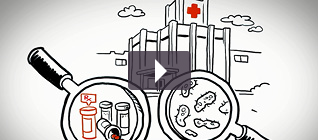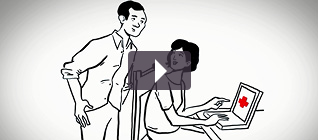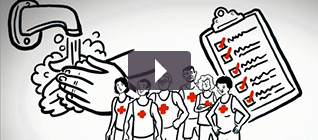Englewood Hospital and Medical Center








NEWOrder 2½ years of detailed scoring for this hospital for $2.95
- Infections
- Problems with Surgery
- Safety Problems
- Practices to Prevent Errors
- Doctors, Nurses & Hospital Staff
This Hospital's Score:
0.808
Best Hospital's Score:
0.000
Average Hospital's Score:
0.689
Worst Hospital's Score:
2.685
MRSA infection
Staph bacteria are common in hospitals, but Methicillin-resistant Staphylococcus aureus (MRSA) is a type of staph bacteria that is resistant to (cannot be killed by) many antibiotics. MRSA can be found in bed linens or medical equipment and can be spread if providers do not properly wash their hands between patients. MRSA can cause life-threatening bloodstream infections, pneumonia and surgical site infections.
This number represents a comparison of the number of infections that actually happened at this hospital to the number of infections expected for this hospital, given the number of patients they care for on a daily basis and how widespread MRSA infection is in their local community. A number lower than one means fewer infections than expected; a number more than one means more infections than expected. For details on sources, click here.
What safer hospitals do:
Doctors and nurses should clean their hands after caring for every patient. Hospital rooms and medical equipment should be thoroughly cleaned often. Safer hospitals will also keep MRSA patients separate from other patients and require providers and visitors to wear gloves and gowns around these patients.
This Hospital's Score:
0.441
Best Hospital's Score:
0.000
Average Hospital's Score:
0.370
Worst Hospital's Score:
1.486
C. diff infection
Clostridium difficile (C. diff) is a bacterium that can cause diarrhea, abdominal pain, loss of appetite, and fever. Most C. diff cases occur in patients taking or having recently taken antibiotics, and fully killing the bacteria in an infected patient can be very difficult. C. diff can spread via contaminated equipment or by providers who fail to properly wash their hands between patients.
This number represents a comparison of the number of infections that actually happened at this hospital to the number of infections expected for this hospital, given the number of patients they care for on a daily basis and how widespread C. diff infection is in their local community. A number lower than one means fewer infections than expected; a number more than one means more infections than expected. For details on sources, click here.
What safer hospitals do:
Doctors and nurses should clean their hands after caring for every patient. Hospital rooms and medical equipment should be thoroughly cleaned often. Safer hospitals will also keep C. diff patients separate from other patients, and require providers and visitors to wear gloves and gowns around these patients.
This Hospital's Score:
0.861
Best Hospital's Score:
0.000
Average Hospital's Score:
0.586
Worst Hospital's Score:
2.362
Infection in the blood
If a patient is in the hospital, he or she may be given a central line (a tube inserted into the body to deliver medication and other treatments). Patients with a central line are at high risk for developing a dangerous infection in the blood. These serious infections can lead to other complications, increase recovery time, and can often lead to death.
This number represents a comparison of the number of central line-associated infections in the blood that actually happened at this hospital to the number of infections expected for this hospital, given the number of central lines used and other factors like facility type and size. A number lower than one means fewer infections than expected; a number more than one means more infections than expected. For details on sources, click here.
What safer hospitals do:
Hospital staff follows special guidelines when inserting central lines, often including a checklist of steps to follow. They properly maintain a patient’s central line to prevent infection.
This Hospital's Score:
0.831
Best Hospital's Score:
0.000
Average Hospital's Score:
0.522
Worst Hospital's Score:
2.399
Infection in the urinary tract
If a patient is in the hospital, he or she may require a urinary catheter. Patients with catheters are at risk for developing a dangerous infection in the urinary tract. These serious infections can lead to other complications, increase recovery time, and can often lead to death.
This number represents a comparison of the number of catheter-associated infections in the urinary tract that actually happened at this hospital to the number of infections expected for this hospital, given the number of catheters used and other factors like facility type and size. A number lower than one means fewer infections than expected; a number more than one means more infections than expected. For details on sources, click here.
What safer hospitals do:
Hospital staff regularly clean and maintain urinary catheters to prevent infection. They also know when and how to safely remove a catheter.
This Hospital's Score:
0.706
Best Hospital's Score:
0.000
Average Hospital's Score:
0.856
Worst Hospital's Score:
3.229
Surgical site infection after colon surgery
This infection happens after surgery in the part of the colon where the surgery took place. These infections can be very serious, and may spread throughout the body. A patient with this type of infection often faces a long recovery in the ICU. Some people even die from the infection.
This number represents a comparison of the number of infections after colon surgery that actually happened at this hospital to the number of infections expected for this hospital, given the types of patients they care for and other factors like a patient’s age and type of surgery. A number lower than one means fewer infections than expected; a number more than one means more infections than expected. For details on sources, click here.
What safer hospitals do:
The hospital team uses appropriate antibiotics before surgery, cleans the skin with a special soap that kills germs, and closely watches patients during and after major colon surgeries.
This Hospital's Score:
4.17
Best Hospital's Score:
1.95
Average Hospital's Score:
5.62
Worst Hospital's Score:
12.56
Sepsis infection after surgery
Sepsis is your body’s extreme reaction to an infection. All types of surgeries can put a patient at risk of infection that can lead to sepsis. This could be infection where the skin was cut, or an infection that develops after the surgery, like pneumonia. Sepsis requires immediate treatment or the patient may experience lifelong complications including organ failure. Some patients may die if sepsis is not treated quickly.
This number represents the number of surgical patients that experienced a sepsis infection for every 1,000 people who had surgery. For details on sources, click here.
What safer hospitals do:
Hospital staff closely monitor patients for signs of sepsis following surgical procedures, including a high heart rate, low blood pressure, fatigue, confusion, and severe pain.
This Hospital's Score:
0.000
Best Hospital's Score:
0.000
Average Hospital's Score:
0.011
Worst Hospital's Score:
0.256
Dangerous object left in patient’s body
A surgeon can accidentally leave an object inside a patient’s body during surgery. Most times the object is a surgical sponge, which can quickly get infected. This problem doesn’t happen often, but if it does happen it can be extremely dangerous. Many patients become severely ill, disabled, or even die.
This number represents the number of times dangerous objects were left inside patients for every 1,000 people discharged. For details on sources, click here.
What safer hospitals do:
The hospital team follows a strict procedure to count sponges and tools in the operating room. The hospital may use an electronic scanning system where each object is scanned before and after surgery to ensure they haven’t left any objects inside the patient.
This Hospital's Score:
1.67
Best Hospital's Score:
1.13
Average Hospital's Score:
1.87
Worst Hospital's Score:
4.00
Surgical wound splits open
After a major surgery on the stomach or abdomen area, the healthcare team must be careful to make sure that the surgical stitches don’t break open. This could leave the wound exposed. A surgical wound splitting open is very painful and puts the patient at risk for infection.
This number represents the number of times surgical wounds in the stomach or abdomen area split open for every 1,000 people who had surgery on their abdomen. For details on sources, click here.
What safer hospitals do:
Doctors and nurses monitor surgical wounds to make sure they are healing and that the stitches are still in place. The staff also counsels patients on avoiding heavy lifting or intense physical activity after surgery.
This Hospital's Score:
185.57
Best Hospital's Score:
84.66
Average Hospital's Score:
177.47
Worst Hospital's Score:
235.51
Death from treatable serious complications
Sometimes after surgery, patients can develop serious complications while they are in the hospital. They might catch pneumonia, have a heart attack, or lose function in their kidneys or liver. These problems are serious but can be treated by a good hospital team. If the hospital doesn’t manage the patient’s complications correctly, the patient could die.
This number represents the number of surgical patients that died for every 1,000 people who had a serious treatable complication after surgery. For details on sources, click here.
What safer hospitals do:
The staff communicates well to quickly identify if there is a serious complication after surgery. They are ready to take action with an aggressive plan using patient safety guidelines.
This Hospital's Score:
1.94
Best Hospital's Score:
1.01
Average Hospital's Score:
2.42
Worst Hospital's Score:
5.53
Blood Leakage
If blood vessels become injured during surgery, they may leak excess blood within the body. In some cases, the blood leak will clump up or clot. In other cases, the blood leak is active and ongoing. Both blood clots and internal bleeding can cause significant damage to the body’s organs, potentially leading to organ failure or even death.
This number represents the estimated number of times patients experienced blood leakage during a procedure for every 1,000 people who had surgery. For details on sources, click here.
What safer hospitals do:
Before finishing a surgical procedure, surgeons and hospital staff should carefully examine the patient’s body cavity for potential blood leaks. Surgical sites should be sewn or fused shut completely before the body is closed.
This Hospital's Score:
1.42
Best Hospital's Score:
0.74
Average Hospital's Score:
1.69
Worst Hospital's Score:
4.60
Kidney injury after surgery
After major surgery, particularly heart surgery, some patients may experience kidney failure. In serious cases, kidney failure can lead to the need for dialysis, an artificial way of replacing the kidneys’ function. In the most extreme cases, a patient may need a kidney transplant or risk death. Patients who are older or have other pre-existing health problems are at a greater risk of experiencing kidney failure.
This number represents the estimated number of times patients experienced kidney failure for every 1,000 people who had surgery. For details on sources, click here.
What safer hospitals do:
Hospital staff should regularly test a patient’s blood for changes in levels of chemicals and hormones. They should also monitor urine output. Close monitoring can allow a patient to be treated for kidney failure quickly before long-term and irreversible damage is done.
This Hospital's Score:
4.74
Best Hospital's Score:
1.94
Average Hospital's Score:
10.52
Worst Hospital's Score:
57.80
Serious breathing problem
After surgery some patients can develop a serious breathing problem. Their lungs either cannot take in enough oxygen or cannot get rid of carbon dioxide. Without immediate care, the patient can lose consciousness, fall into a coma, or even die.
This number represents the number of times patients experienced serious breathing problems for every 1,000 people who had surgery. For details on sources, click here.
What safer hospitals do:
Doctors and nurses watch carefully for symptoms like shortness of breath so they can prevent serious breathing problems.
This Hospital's Score:
0.57
Best Hospital's Score:
0.28
Average Hospital's Score:
0.89
Worst Hospital's Score:
2.41
Accidental cuts and tears
For procedures of the abdomen and pelvis, there is a chance that the patient will suffer an accidental cut or tear of their skin or other tissue. This problem can happen during surgery or a procedure where doctors use a tube to look into a patient’s body.
This number represents the number of times patients experienced accidental cuts and tears in the abdominal or pelvic region during a procedure for every 1,000 people discharged. For details on sources, click here.
What safer hospitals do:
Hospital staff is careful when using scalpels, knives, and other surgical tools so that they don’t accidentally cut or tear the patient’s skin and tissues.
This Hospital's Score:
0.60
Best Hospital's Score:
0.53
Average Hospital's Score:
1.00
Worst Hospital's Score:
3.10
Harmful Events
Patients can experience complications and potentially harmful events following a surgery, a procedure, or childbirth. When all of these errors are examined together, it gives a better picture of a hospital’s ability to keep its patients safe.
This number represents the number of times patients experienced dangerous safety-related adverse events for every 1,000 people discharged. For details on sources, click here.
What safer hospitals do:
These potentially avoidable safety events represent opportunities for improving patient care. Staff should document when errors happen, discuss how the error occurred, and develop a plan to prevent future errors.
This Hospital's Score:
0.12
Best Hospital's Score:
0.05
Average Hospital's Score:
0.64
Worst Hospital's Score:
7.50
Dangerous bed sores
A bed sore is a sore or wound on the skin that forms when a patient lays or sits in one position for too long without being moved. Advanced bedsores (also known as stage 3 or 4 pressure ulcers) can become large and very deep. They can reach a muscle or bone and cause severe pain and serious infection. This can lead to longer hospital stays, amputation, or even death.
This number represents the number of times patients experienced dangerous bed sores for every 1,000 people discharged. For details on sources, click here.
What safer hospitals do:
When working with a patient who cannot move much on their own, hospital staff moves the patient regularly and checks for bed sores. They also use cushioning to protect bony areas and immediately take steps to treat existing sores.
This Hospital's Score:
0.417
Best Hospital's Score:
0.000
Average Hospital's Score:
0.338
Worst Hospital's Score:
1.748
Patient falls and injuries
One common problem that patients face in the hospital is a serious injury or death resulting from a fall or other kind of trauma. Falls can happen when patients who really can’t walk on their own try getting out of bed, often to go to the restroom. Patient falls increase time in the hospital, require additional care, and can result in permanent disability.
This number represents the number of times patients experienced falls or other types of trauma for every 1,000 people discharged. For details on sources, click here.
What safer hospitals do:
Hospital staff assist patients when they want to get up to use the restroom or move around the hospital. Leadership and staff make sure that the hospital environment is clear of hazards that could cause a fall or other trauma. Patient beds may be equipped with alarms to alert staff if a patient who is at risk of falls tries to get out of bed on his or her own. Hospital staff responds quickly to these alarms if they go off.
This Hospital's Score:
0.25
Best Hospital's Score:
0.15
Average Hospital's Score:
0.29
Worst Hospital's Score:
0.56
Falls causing broken hips
Patients in the hospital, especially those who are older or have weaker bones, are at risk of breaking their hip if they fall. Broken hips can delay a patient’s recovery time, require longer hospital stays, and cause depression when patients lose their ability to move.
This number represents the number of times patients experienced hip fractures for every 1,000 people discharged. For details on sources, click here.
What safer hospitals do:
Hospital staff should ensure patients know how to request assistance when they want to get out of bed. Rooms should be kept free of all hazards that may cause a patient to trip and fall. Patients should be provided with non-slip socks and garments that will not get in the way when they are trying to move.
This Hospital's Score:
0.34
Best Hospital's Score:
0.10
Average Hospital's Score:
0.25
Worst Hospital's Score:
0.65
Collapsed lung
A collapsed lung is when air leaks out of the lung and goes into the area between the lungs and the chest wall. It can happen when a doctor or nurse is inserting a catheter, a feeding tube, or even a pacemaker. This kind of lung injury can be serious and can cause severe chest pain and other complications.
This number represents the number of times patients experienced collapsed lungs for every 1,000 people discharged. For details on sources, click here.
What safer hospitals do:
Hospital staff is well-trained on how to insert and remove tubes from the chest area so that the patient’s lungs do not collapse.
This Hospital's Score:
2.65
Best Hospital's Score:
1.56
Average Hospital's Score:
3.90
Worst Hospital's Score:
8.15
Dangerous blood clot
A blood clot is a gathering of blood cells in a vein, which can be caused by damage to tissue during surgery. Most blood clots form in the leg but the clot can break away and travel through the bloodstream to other areas of the body. If the clot travels to the lungs and gets stuck, it can prevent oxygen from getting into the blood. This can lead to chest pain, unconsciousness, and even death.
This number represents the number of times patients experienced dangerous blood clots for every 1,000 people who had surgery. For details on sources, click here.
What safer hospitals do:
Doctors use compression devices to apply pressure to areas of the body where a blood clot might form. They also give patients blood thinners and closely watch patients that might be at risk to prevent dangerous blot clots. It also helps to get patients out of bed and walking around as soon as possible after surgery.
This Hospital's Score:
0.000
Best Hospital's Score:
0.000
Average Hospital's Score:
0.001
Worst Hospital's Score:
0.050
Air or gas bubble in the blood
An air or gas bubble (air embolism) stops blood from flowing through the body. This serious mistake can happen during surgery or other procedures, like getting an injection. If blood flow is blocked, a patient can suffer a stroke or die.
This number represents the number of times patients had an air or gas bubble in the blood for every 1,000 people discharged. For details on sources, click here.
What safer hospitals do:
Staff is careful when inserting or removing a tube from a major vein to guard against air or gas getting into a patient’s bloodstream. All staff is trained to safely put in and take out catheters and other tubes. The hospital encourages staff to work as a team and closely watch patients during and after surgery to quickly detect an air embolism if it does happen.
This Hospital's Score:
100
Best Hospital's Score:
100
Average Hospital's Score:
82.22
Worst Hospital's Score:
15
Doctors order medications through a computer
Hospitals can use Computerized Physician Order Entry (CPOE) systems to order medications for patients in the hospital, instead of writing out prescriptions by hand. Good CPOE systems alert the doctor if they try to order a medication that could cause harm, such as prescribing an adult dosage for a child. CPOE systems help to reduce medication errors in the hospital.
Hospitals can earn up to 100 points for using a well-functioning CPOE system in most areas of the hospital. For details on sources, click here.
What safer hospitals do:
Hospitals use CPOE systems in all areas of the hospital and regularly test those systems to ensure they are alerting doctors to potential ordering errors.
This Hospital's Score:
100
Best Hospital's Score:
100
Average Hospital's Score:
85.20
Worst Hospital's Score:
25
Safe medication administration
Using barcodes on medications, nurses can scan the medication and then the patient’s ID bracelet to make sure the patient is receiving the right medications. If the bar codes do not match, this signals there is an error, giving nurses and doctors the chance to confirm they have the right patient, right medication, and right dose. Bar code medication administration (BCMA) systems are proven to reduce the risk that a hospital accidentally gives the wrong medication to a patient.
Hospitals earn up to 100 points for using a well-functioning bar coding system for all medication orders, and making sure it is used properly to keep patients safe. For details on sources, click here.
What safer hospitals do:
When hospitals use bar coding technology effectively for all orders, medication errors happen far less frequently.
This Hospital's Score:
100
Best Hospital's Score:
100
Average Hospital's Score:
76.81
Worst Hospital's Score:
15
Handwashing
Healthcare workers can help stop infection and illness by carefully cleaning their hands. When hospital staff does not carefully wash their hands, they can spread germs from one patient to another and cause someone to become seriously ill.
Hospitals can earn up to 100 points for having a handwashing policy and evaluating how hospital workers follow that policy. For details on sources, click here.
What safer hospitals do:
Hospitals provide training and implement policies to make sure that all hospital staff cleans their hands before touching a patient.
This Hospital's Score:
73
Best Hospital's Score:
88
Average Hospital's Score:
74.64
Worst Hospital's Score:
59
Communication about medicines
Patients’ perspectives of care are an important part of patient safety. The Communication about Medicines measure reflects patients’ feedback on how often hospital staff explained the purpose of any new medicine and what side effects that medicine might have. Effective communication about medicine prevents misunderstandings that could lead to serious problems for a patient.
Based on a scale of zero-100, this number represents a comparison of patients’ perspectives of how effectively this hospital communicated with patients about their medications relative to patients’ perspectives of how effectively other hospitals communicated with their patients. Higher scores indicate more effective communication than lower scores. For details on sources, click here.
What safer hospitals do:
Hospitals that score well on this measure take time to speak with every patient to ensure that the patient understands the purpose of any new medication they are given, how to take the medication, and the risk of any possible side effects.
This Hospital's Score:
81
Best Hospital's Score:
94
Average Hospital's Score:
85.48
Worst Hospital's Score:
67
Communication about discharge
Patients’ perspectives of care are an important part of patient safety. The Communication about Discharge measure summarizes how well the hospital staff communicated with patients about the help they would need at home after leaving the hospital. The measure also summarizes how often patients reported that they were given written information about symptoms or health problems to watch for during their recovery. Educating patients on the steps they need to take during their recovery at home reduces the chances that a patient will need to be readmitted to the hospital.
Based on a scale of zero-100, this number represents a comparison of patients’ perspectives of how effectively this hospital communicated with patients about the help they would need after discharge relative to patients’ perspectives of how effectively other hospitals communicated with their patients. Higher scores indicate more effective communication than lower scores. For details on sources, click here.
What safer hospitals do:
Hospitals that score well on this measure take time with every patient to clarify the patient’s responsibilities during her recovery at home, clarify the responsibilities of caregivers at home, and educate the patient on any symptoms that could point to problems in the recovery process.
This Hospital's Score:
120.00
Best Hospital's Score:
120.00
Average Hospital's Score:
117.27
Worst Hospital's Score:
0.00
Staff work together to prevent errors
A hospital that has a strong culture of safety has a well-functioning team with good leaders who catch errors before they can harm a patient. Patients are less likely to experience mistakes if hospital staff works together. Staff should also be comfortable speaking up when they sense an error might happen.
Hospitals can earn up to 120 points for measuring culture of safety, providing feedback to staff, and creating new plans to prevent errors. For details on sources, click here.
What safer hospitals do:
Hospitals regularly survey their physicians, nurses, and other staff on the culture of safety to measure how well staff works together to keep patients safe. Then, hospitals provide feedback on the results to leaders and hospital staff and create plans to improve.
This Hospital's Score:
120.00
Best Hospital's Score:
120.00
Average Hospital's Score:
117.60
Worst Hospital's Score:
46.15
Effective leadership to prevent errors
Errors are much more common if hospital leaders don’t make patient safety a priority. Leaders must make sure that all hospital staff knows what they need to work on and that they are held accountable for improvements. The hospital should also budget money towards improving safety.
Hospitals can earn up to 120 points for having leadership structures that increase awareness of patient safety issues and holding leadership accountable for improvements. For details on sources, click here.
What safer hospitals do:
Hospital leaders are aware of the hospital’s patient safety problems, work with hospital staff to fix them, and share their efforts with the larger community. Leaders also make it a priority to learn about and use the best methods to prevent errors and are held accountable for identifying and reducing unsafe practices.
This Hospital's Score:
100
Best Hospital's Score:
100
Average Hospital's Score:
79.09
Worst Hospital's Score:
15
Nursing and Bedside Care for Patients
Studies show better staffing practices have a meaningful impact on the quality and safety of patient care. When hospitals have more nurses and assistive personnel, patients are more likely to have better experiences and improved health outcomes. Without enough nurses, patients might face complications, longer hospital stays, and even death.
Hospitals can earn up to 100 points for this measure for staffing their hospitals with enough nurses (RNs), licensed practical nurses (LPNs), and unlicensed assistive personnel (UAPs). For details on sources, click here.
What safer hospitals do:
Hospitals should ensure they have enough nurses trained to provide direct patient care like patient monitoring, symptom assessment, and medication administration in medical, surgical, and med-surg units.
This Hospital's Score:
100
Best Hospital's Score:
100
Average Hospital's Score:
67.86
Worst Hospital's Score:
5
Specially trained doctors care for ICU patients
A critical care unit or Intensive Care Unit (ICU) is a special part of the hospital that provides care for extremely ill patients. Hospitals should have special doctors called intensivists working in the ICU. Intensivists are physicians with advanced training in intensive or critical care. They learn to manage problems in the ICU and help to reduce errors. There are higher death rates in hospitals where ICU patients are not cared for by intensivists.
Hospitals can earn up to 100 points for staffing their ICUs with intensivists. For details on sources, click here.
What safer hospitals do:
Hospitals staff ICUs with physicians who have training in critical care medicine.
This Hospital's Score:
90
Best Hospital's Score:
97
Average Hospital's Score:
89.99
Worst Hospital's Score:
75
Communication with doctors
Patients’ perspectives of care are an important part of patient safety. The Communication with Doctors measure summarizes how well patients feel their doctors explained things clearly, listened carefully to them, and treated them with courtesy and respect. Effective communication between doctors and patients can be reassuring to patients and can help prevent errors like medication mix-ups or misdiagnoses.
Based on a scale of zero-100, this number represents a comparison of patients’ perspectives of how effectively physicians at this hospital communicated with patients relative to patients’ perspectives of how effectively physicians at other hospitals communicated with their patients. Higher scores indicate more effective communication than lower scores. For details on sources, click here.
What safer hospitals do:
Hospitals that score well on this measure encourage their doctors to take time with every patient to communicate effectively by listening well, answering questions, treating patients with courtesy and respect, and explaining diagnoses and treatment plans in ways that patients understand.
This Hospital's Score:
91
Best Hospital's Score:
97
Average Hospital's Score:
90.37
Worst Hospital's Score:
76
Communication with nurses
Patients’ perspectives of care are an important part of patient safety. The Communication with Nurses measure summarizes how well patients feel that their nurses explained things clearly, listened carefully to them, and treated them with courtesy and respect. Effective communication between nurses and patients can be reassuring to patients and can prevent errors like medication mix-ups or misdiagnoses.
Based on a scale of zero-100, this number represents a comparison of patients’ perspectives of how effectively nurses at this hospital communicated with patients relative to patients’ perspectives of how effectively nurses at other hospitals communicated with their patients. Higher scores indicate more effective communication than lower scores. For details on sources, click here.
What safer hospitals do:
Hospitals that score well on this measure encourage their nurses to take time with every patient to communicate effectively by listening well, answering questions, treating patients with courtesy and respect, and explaining diagnosis and treatment plans in ways that patients understand.
This Hospital's Score:
80
Best Hospital's Score:
96
Average Hospital's Score:
81.81
Worst Hospital's Score:
62
Responsiveness of hospital staff
Patients’ perspectives of care are an important part of patient safety. The Responsiveness of Hospital Staff measure looks at patients’ feedback on how long it takes for a staff member to respond when they request help. If a patient is in pain, experiencing new symptoms, or cannot reach the bathroom himself, it is important that hospital staff respond quickly to address the situation.
Based on a scale of zero-100, this number represents a comparison of patients’ perspectives of how quickly the staff at this hospital typically responds to patients’ requests for help relative to patients’ perspectives of how quickly the staff at other hospitals typically respond to their patients’ requests. Higher scores indicate a faster response time than lower scores. For details on sources, click here.
What safer hospitals do:
Hospitals that score well on this measure are well-staffed and have systems in place to make sure that all patients receive the care they need quickly.
Notes and Definitions
1. Declined to Report: The hospital was asked to provide this information to the public, but did not.
2. Not Available: “Not Available” means that the hospital does not have data for this measure. This could be because the measure is related to a service the hospital does not provide. For example, a hospital that does not have an ICU would not be able to report data about ICUs. It could also be because the hospital had too few patients or cases to report data for a particular condition or procedure. A “Not Available” result does not mean that the hospital withheld information from the public.
3. Straight A: The hospital has earned an 'A' Grade for five consecutive grading rounds or more, qualifying it for recognition as a “Straight A” hospital.
LEGAL DISCLAIMER: The Leapfrog Hospital Safety Grade scores hospitals on their overall performance in keeping patients safe from preventable harm and medical errors. The grades are derived from expert analysis of publicly available data using up to 31 evidence-based, national measures of hospital safety. No specific representation is made, nor shall be implied, nor shall The Leapfrog Group be liable with respect to any individual patient’s potential or actual outcome as a result of receiving services performed at any of these hospitals. Leapfrog Hospital Safety Grades cannot be republished without expressed written permission from The Leapfrog Group.








